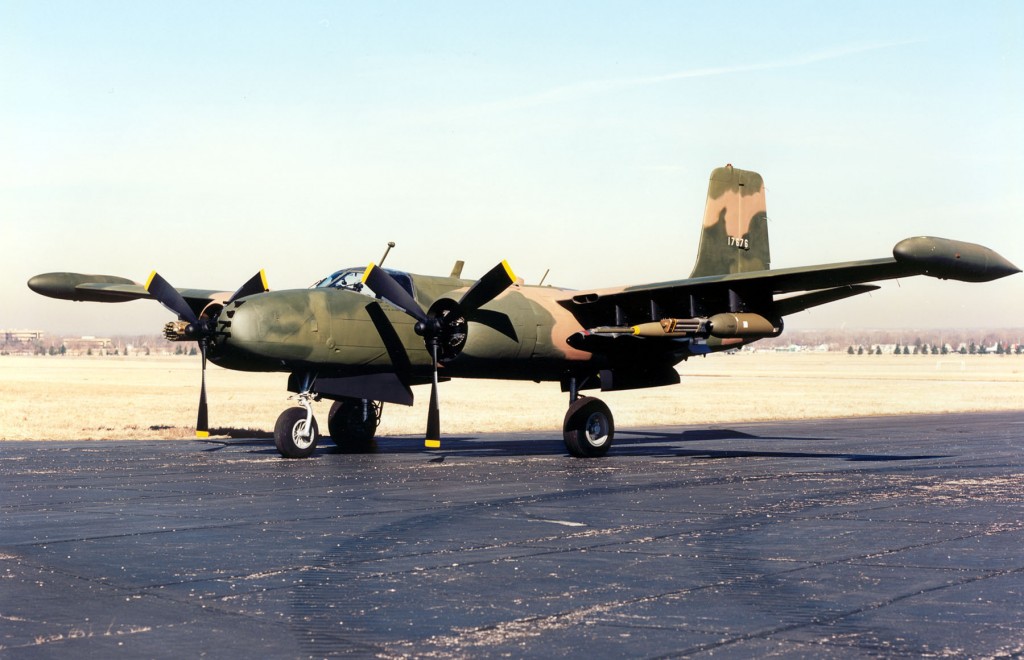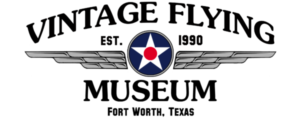
The Douglas A-26K Counter Invader is a highly modified version of the Douglas A-26 Invader, a World War II attack bomber. The Invader served again during the Korean War (1950-1953), mainly as a night intruder against North Korean supply lines. It was removed from service in 1958, but in 1961 the USAF recalled many Invaders for use as tactical bombers in Southeast Asia. Combat duty and two decades of wear took their toll, and in 1964 the A-26s again were removed from service.
In 1966 the old bomber was resurrected once more when the improved A-26K Counter Invader returned to Southeast Asia for ground-attack missions along the Ho Chi Minh Trail. With the success of the YA-26K test program, the USAF ordered 40 A-26s converted to A-26K standards. The A-26K differed from the A-26B in a few areas. First, the Pratt & Whitney R-2800-27 engines of the A-26B were changed to the R-2800-52W, giving it 500 more horsepower per engine. The six .50-cal. machine guns mounted in the wings were removed also. The A-26K still retained considerable firepower with eight .50-cal. machine guns in the nose, 4,000 pounds of bombs carried in the bomb bay and up to 8,000 pounds of mixed ordnance carried externally on eight wing pylons. This was a big improvement over the 2,000 pound wing ordnance capacity of a WWII A-26B. The dorsal and ventral turrets were removed. An anti-skid brake system installed and the original Hamilton Standard propellers were replaced with larger “paddle blade” reversing propellers to allow it to land on shorter runways. Wing tip fuel tanks were added also.
A $12.6 million dollar contract was signed with On Mark Engineering Co. and the 40 aircraft were converted in 1963 and 1964. Because the aircraft were totally rebuilt back to zero time airframes, the aircraft were assigned 1964 serial numbers, although all were originally built in the early 1940s.
The A-26K conversions were completed in 1965 when the last of 40 A-26s (the one before you) rolled out of the On Mark Engineering hangars in California. The A-26K was designed for counter insurgency missions in Southeast Asia. The USAF needed an aircraft to seek and destroy supplies moving towards and into South Vietnam from the north.
Because of the urgent need for counter insurgency and interdiction aircraft, the USAF began using A-1E Skyraiders for these missions and the A-26Ks were not used in combat until 1966. Between 1964 and 1966, the A-26Ks were assigned to Special Operations Squadrons (SOS), Air Commando Squadrons (ACS) and composite fighter squadrons. The K models were basically combat trainers during this period.
In 1966 the USAF decided to base a squadron of A-26Ks in Thailand for use in the panhandle area of Laos in support of operation Steel Tiger. Since the Thai government restricted USAF bombers from using its bases, the designation of the aircraft was changed to A-26A, even though no changes were made to the aircraft or its mission.
Five A-26K’s were also sent to the Congo during the Revolution in 1964 and used by the CIA. All A-26K’s were delivered by On Mark with conversion kits so that the gun nose could be replaced by a glass nose and reconnaissance cameras could be mounted in the nose and bomb bay. They were used to map many areas of Central and South America before being sent to Thailand.
Project Big Eagle was a Detachment of the 603rd Air Commando Squadron. After the concept was proven with 6 airplanes, the 609th Special Operations Squadron became the major unit to run combat operations with up to 15 airplanes at a time at Nakhon Phanom (NKP), Thailand, until late 1969.
The aircraft were withdrawn from service although they were very effective in their mission. It was attributed to the efforts of certain Air Force General Officers who wanted an all jet Air Force regardless of whether a propeller driven aircraft was better suited to the job. An excuse was given that the aircraft were getting too old for combat, but the reality was that they had been completely refurbished no more than three years previously. If operations had continued, ’679 was next in line to be shipped over. It was fortuitous that this National Treasure took a new road to its destiny. It now represents the heroic actions of the men who flew and maintained the A-26A in secret missions over Laos during the Vietnam War.
General characteristics:
- Crew: 2
- Pilot
- Navigator
- Length: 51 ft. 7 in.
- Wingspan: 71 ft. 6 in.
- Height: 19 ft
- Empty Wt: 25,130 pounds
- Max. Gross Wt: 43,380 pounds
- Powerplant: 2x PW R2800-52W “Double Wasp” Radial Engines @ 2500 hp each
Performance:
- Maximum speed: 385 mph/ 335 kts
- Range: 2700 Statute mi. / 2,346 Nm
- Service ceiling: 31,000 ft
Armament:
- Guns:
- 8 x .50 cal. M2 Browning machine guns
- Bombs:
- 8,000 lb of mixed ordnance on 8 wing pylons
- 4,000 lb internal bomb bay
Douglas A-26B Invader S/N 44-34198 History
A-26B Invader S/N 44-34198 was originally manufactured by Douglas Aircraft, Long Beach, CA and delivered to the US Army Air Forces on March 15, 1945.
- March 1945: To Staging Area, Hunter AAF GA
- April 1945: Departed the US and assigned to Eighth Air Force, European Theater of Operations
- July 1945: Returned to US via Hunter AAF, storage at 4255th AAF Base Unit (Air Materiel Command), Grenada AAF MS
- March 1946: To 4160th AAF Base Unit (AMC), Hobbs AAF TX (storage)
- February 1947: To 4127th AAF Base Unit (AMC), McClellan AFB CA
- May 1947: To 197th Fighter Squadron (Air National Guard), Luke AFB AZ (to TA-26B)
- May 1949: To 198th Fighter Squadron (ANG), Isla Grande MAP PR
- March 1951: To 202nd Tow Target Flight (ANG), Lockbourne AFB OH
- June 1951: To 2nd Tow Target Squadron (Tactical Air Command), New Castle MAP DE
- December 1953: To 2nd Tow Target Squadron (TAC), Mitchell AFB NY
- July 1958: To Arizona Aircraft Storage Branch (AMC), Davis-Monthan AFB AZ
- May 1961: To Ogden Air Logistics Area, Hill AFB UT (to A-26B)
- September 1961: To 4400th Combat Crew Training Squadron (TAC), Eglin AFB FL
- May 1962: To 1st Materiel Squadron (TAC), Hurlburt Field FL
- October 1962: To 2704th Aircraft Storage and Disposition Group (AFLC), Davis-Monthan AFB
- June 1963: To 1st Air Commando Wing (TAC), Hurlburt Field
- April 1964: To On Mark Engineering, Van Nuys CA
- April 1965: Dropped from USAF inventory by remanufactured as A-26K s/n 64-17679
Douglas A-26K Counter Invader S/N 64-17679
Remanufactured by On Mark Engineering, Van Nuys CA and gained into USAF inventory on April 13, 1965.
- April 1965: To 1st Air Commando Wing (Tactical Air Command), Hurlburt Field FL
- Dec 1965: To 603rd Air Commando Squadron (TAC), England AFB LA
- Nov1967: To Sacramento Air Logistics Area, McClellan AFB CA
- March 1969: To 1st Special Operations Wing (TAC), England AFB
- July 1969: To 603rd Special Operations Wing (TAC), Hurlburt Field
- Oct 1969: To Military Aircraft Storage and Disposition Center, Davis- Monthan AFB AZ
- Sept 1971: Dropped from inventory by transfer to other agency
Note: ‘679 was used to train crews at England AFB and Hurlburt Field and never deployed to Thailand. This is probably why she is still with us today!
‘679 in Civilian Life:
In May 1971 it was transferred from the USAF at Davis-Monthan AFB to the State of Georgia Forestry Commission. They obtained three aircraft in this manner intending to make fire bombers out of them, but never accomplished the modifications due to a change in the rules from the US Forest Service. They were declared surplus in 1978 and all three were sold thru a broker to Air Spray, a Canadian fire bomber company who intended to convert them to air tankers. Two of the aircraft were transferred successfully, but ‘679 was wrecked during a landing accident at Macon, GA and was never converted.
Later in 1978, Rob Stuessy, a mechanic from Lynch Air Tankers was sent by Denny Lynch to see if there were any salvageable parts. Rob assessed it and determined that it might be made flyable again. He convinced Denny to send the parts and equipment to Macon to get it in flying condition for the flight to Billings, MT, where the rest of the work could be accomplished. ‘679 remained with the company, but was never converted to a tanker. Denny and others in the company wanted to preserve it and show it at airshows.
Following the passing of Denny Lynch in 2005, the family decided to sell the aircraft. It was purchased and ferried to Ft Worth to become part of the Greatest Generation Aircraft Non Profit Foundation’s collection in 2010. The restoration work continues with a goal of the summer of 2014 for a return to flight. Once it returns to flight status, it will be the only flying A-26K Counter Invader in the world!

